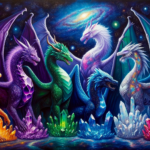White Dragons: an Overview:
White dragons, also known as ice dragons or glacial wyrms, are the smallest and most enigmatic among the classic chromatic dragons. Despite their diminutive size, they are by no means harmless. These solitary and feral creatures are known for their chaotic evil nature and their mastery of the cold. White dragons are highly adapted to their arctic habitats, boasting impressive memories and an unyielding connection to their surroundings. Their breath weapon consists of a frigid cone of ice or frost. This fact file delves into the icy world of white dragons, unveiling their distinctive characteristics, arctic habitats, behaviour, and their role as formidable adversaries.
Physical Characteristics:
- Appearance: White dragons possess lean, sinewy bodies, built for manoeuvrability in icy environments.
- Scales: Their scales are a brilliant, glistening white, camouflaging them amidst the snow and ice of their arctic homes.
- Eyes: These dragons boast keen, icy blue eyes that pierce through the frozen wilderness.
- Size: Although the smallest among chromatic dragons, white dragons still reach impressive lengths, typically spanning between thirty to fifty feet.
Habitat:
- White dragons are most at home in the unforgiving terrain of arctic regions, where they establish their lairs deep within icy caves and secluded glacial crevices.
Behaviour and Abilities:
- Feral and Chaotic: White dragons are feral and unpredictable, driven by their chaotic evil nature and a primal instinct for survival.
- Arctic Mastery: They are exceptionally well-adapted to their arctic habitats, thriving in extreme cold and exhibiting an innate understanding of their surroundings.
- Cold Breath Weapon: These dragons breathe a frigid cone of ice or frost, capable of freezing anything in its path, leaving their foes encased in ice.
- Solitary Predators: They are solitary predators, stealthily stalking their prey and exhibiting an unyielding determination in the hunt.
- Excellent Memory: White dragons possess remarkable memories, which help them navigate the vast expanses of their snowy domains.

Cultural Significance of White Dragons:
- Symbols of Harsh Winter: White dragons symbolise the unforgiving cold of winter, the harshness of nature, and the primal survival instincts that come to the forefront in arctic environments.
- Exploration of Isolation: Stories featuring these dragons often explore themes of isolation, survival, and the chilling dangers that lurk in the icy wilderness.
- Heroes Confronting the Elements: Heroes who confront them must contend not only with the dragons themselves but also with the unforgiving environment of the arctic.
Legends and Stories:
- Variations in Myth: Different cultures have their own interpretations of white dragon myths, often portraying heroes who must overcome the frigid challenges and primal forces represented by these creatures.
- The Epic of Freyja’s Quest: In the epic tale of Freyja’s Quest, the heroine embarks on a perilous journey through the frozen wastelands to confront the ancient white dragon Isengar, seeking to unlock the secrets hidden within the ice.
White Dragons: a Conclusion:
White dragons, known for their feral nature, mastery of cold, and chaotic evil alignment, are mythical creatures that symbolise the harshness of winter and the primal instincts that come to the forefront in arctic environments. They serve as reminders of the chilling dangers that can lurk in the frozen wilderness and the indomitable spirit required to confront them. While their existence remains confined to the realms of myth and fantasy, the legends of white dragons continue to inspire tales of courage and survival against the unforgiving elements of the world.
For more dragon content please subscribe to the Everything Dragon YouTube Channel or follow us on Instagram




